Kashmir - Paradise on Earth
Kashmir, the "Paradise on Earth", is known for its captivating beauty. It is encircled by three mountain ranges of the Himalayas- Karakoram, Zanaskar and Pir Panjal, running from northwest to northeast. Forming the backdrop of Kashmir, these snow-capped ranges make Kashmir look like a picture straight out of a fairytale. Dazzling rivers, serene lakes, splendid gardens, flowering meadows, etc are some other features of the landscape of the Kashmir valley.
HILL STATIONS IN KASHMIR
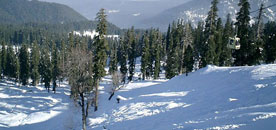
Gulmarg :
Gulmarg is located in the Baramulla district of Jammu and Kashmir. At an amazing altitude of 2730 meters above sea level the hill resort has a gently sloping topography. Gulmarg a prime location in the state of Jammu & Kashmir is about 52 Kms. from Srinagar, the capital of Jammu & Kashmir. At an altitude of 2,653 m., Gulmarg is exquisitely situated in a pine surrounded basin of the Pir Panjal range. Gulmarg or the `Meadow of Flowers' is a lovely blooming sight where an opulence of flora displays various colours with the changing seasons. 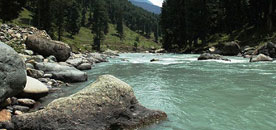
Pahalgam :
Situated at the confluence of the streams flowing from Sheshnag Lake and the Lidder river, Pahalgam (2,130 m) was once a humble shepherd's village with breathtaking views. A number of hotels and lodges cater to all preferences and budgets, from luxurious hotels to unpretentious trekkers' lodges. The most beautiful of these is the huge, undulating meadow of Baisaran, surrounded by thickly wooded forests of pine. Hajan, on the way to Chandanwari, is an idyllic spot for a picnic.
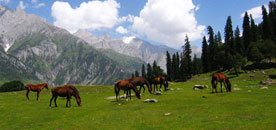
The drive to Sonamarg is through the Sindh Valley which presents yet another spectacular facet of countryside in Kashmir. The Sindh River that meanders through the valley abounds with trout and mahaseer. Ponies can be hired for the trip up to Thajiwas glacier, which is a major local attraction during the summer months. Sonamarg is the base of a major trek that passes along several mountain lakes -Vishansar, Kishansar, Gadsar, Satsar and Gangabal. Sonamarg is also the take off station for the drive to Ladakh across the Zojila, a major pass in the Great Himalayan Range, through which the Srinagar-Leh Road passes.
PILGRIMAGES IN KASHMIR
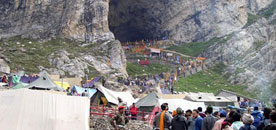
Amarnath Caves : :
Amarnath - Shiva, in the form of a lingam, is formed naturally of an ice - stalagmite. One of the holy trinity, Shiva is a living god. The most ancient and sacred book of India, the Rig Veda evokes his presence in its hymns. Vedic myths, ritual and even astronomy testify to his existence from the dawn of time. The Cave of Amarnath is situated around 145 km away from Srinagar and is dedicated to Lord Shiva. Every year, the government of Jammu and Kashmir organizes a yatra to Amarnath in the month of July and August. It is during this time when the white Shivalingam build of ice starts to take form. 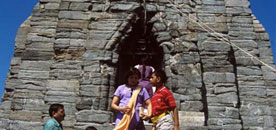
Shankaracharya Temple :
The Shankaracharya temple is situated in the Srinagar district on the hill known as Takht-e-Suleiman. It is housed at a height of 1100 ft. above surface level of the main city on the hill. It is believed that Raja Gopadatya got the temple constructed in 371 BC, giving it the name of Gopadri. The great philosopher Shankaracharya is supposed to have stayed here when he visited Kashmir to revive Sanatan Dharma. This incident, which took place ten centuries ago, led to the renaming of the temple as the Shankracharya temple. 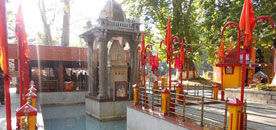
Kheer Bhawani (Tullmul) Temple :
Located at Tullamula in the Srinagar district, it is a very important Hindu Shrine. The temple is associated with the Hindu Godess, Ragnya Devi. An Annual festival takes place here on Jesht Ashtami ( May-June) when Hindus visit the place in huges numbers to offer prayers to seek the blessings of the diety. Devotees also throng on every Shukla Paksh Ashtami round the year & perform HAWANS to please the Mother. The Historic Temple of Kheer Bhawani was built by Maharaja Pratap Singh in 1912 & later renovated by Maharaja Hari Singh. Surrounded by steams, the place abounds in Chinar tree in-and-around the compound Complex within which is a hexagonal Spring wherein diety of Godess Ragyna is decorated in a small white Marble Temple. 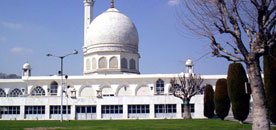
Hazratbal Mosque :
The Hazratbal mosque is situated in Srinagar district, on the western banks of the picturesque Dal Lake. Facing the beautiful Nishat Bagh, the mosque offers a spectacular view of the lake and the mountain afar. This revered shrine houses the Moi-e-Muqqadus (preserved sacred hair) of Prophet Mohammad. Public display of the hair takes place only on religious occasions. Some of the other names of the Hazrat Bal mosque are Assar-e-Sharief, Madinat-us-Sani and Dargah Sharif. One of the most revered Muslim shrines, Hazratbal is an epitome of the love and respect of Muslims for the Prophet. 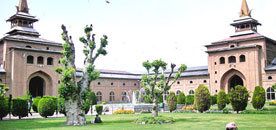
Jama Masjid :
T The Jama Masjid of Srinagar is situated at Nowhatta, in the middle of the old city. An important mosque in Srinagar, it was built by Sultan Sikandar in 1400 AD. Later, the son of Sultan Sikandar, Zain-ul-Abidin got the mosque extended. The attractions of the Jama Masjid of Srinagar, Kashmir include beautiful Indo-Saracenic architecture, a magnificent courtyard and 370 wooden pillars. Another feature of the mosque is the peace and tranquility inside it, standing out against the hustle of the old bazaars around it. Thousands of Muslims assemble at the mosque every Friday to offer their prayers. 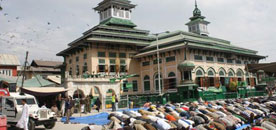
Charar-E-Sharif :
Charar-e-Sharif in Kashmir is the mausoleum of Shaikh Noor-ud-Din Noorani at Charar-e-Sharif. Kashmir, with its immense beauty and piousness holds the whole world enthralled for its virgin mysticism.Which is to be explored by the world,where brotherhood and communal harmony stood ahead among many ways to attain God.The Man,a prophet re-incarnation; Hindu by birth and dharma led masses of his followers among Muslims and Pandits in a unique way.
LAKES & GARDENS IN KASHMIR
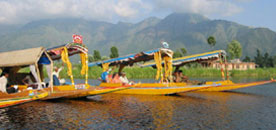
Dal lake of Kashmir is one of the most beautiful and picturesque lakes in India. It has been and continues to be a part of the poetry by some renowned poets. The second largest lake of Jammu and Kashmir state, Dal Lake is encircled by magnificent mountains on three sides. Adorning the banks of the Dal Lake is a number of blooming gardens and orchards.
Five basins and a number of channels well linked with each other are some of the features of the lake. Dal Lake is approximately 6 km by 3 km in size and changes its moods and scenery after every few kilometers.
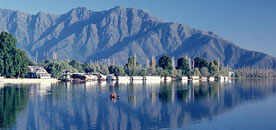
Nageen Lake :
Nageen Lake of Kashmir is an offshoot leading from the Dal Lake. The Nagin Lake is located to the east of the city, at the foothill of the mountain Zabarwan. On the edges of the Nageen Lake are a number of willow and poplar trees. The reflection of these tees in the water of the lake lends it a beautiful view. Surrounded by Shankaracharya hill (Takht-e-Suleiman) on the south and Hari Parbat on the west, the Nagin Lake of Kashmir presents a charming sight. Shikaras, ferrying people to and from the lake, are a fascinating feature of the lake. Bathing boats as well as water-skis and motor launches are also available for hire at the lake. 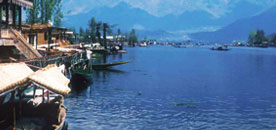
Wular Lake :
Wular Lake in Srinagar is located between the towns of Bandipore and Sopore approximately 60 kilometers from the city of Srinagar. This beautiful lake spreads over an area of over 125 square kilometers and is one of the largest fresh water lakes in Asia. The one very distinguishing feature of the Wular Lake is that it changes character after every few miles of its course.
Wular lake in Srinagar is a perfect example of natural beauty at its best without any artificiality.Some other attractions of the Wular Lake of Srinagar consist of some ruins, standing in the middle of the lake. 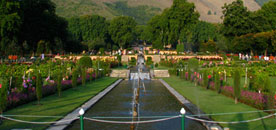
Nishat Garden :
Nishat garden is the largest one of the Mughal gardens in Kashmir. It is situated on the banks of the picturesque Dal Lake. Also known as "the garden of bliss", the Nishat gardens have the Zabarwan Mountains forming its backdrop. Asaf Khan, the brother of Nur Jahan, designed the Kashmir Nishat Bagh in 1633 AD. Within the garden are ruins of some of the buildings dating back to the Mughal period. One of them is a double story pavilion enclosed on two sides with latticed windows. There is also a small spring behind the garden, known as Gopi Tirth. It is a source of supply of crystal clear water to the garden. 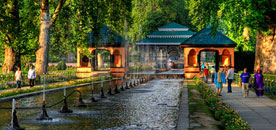
Shalimar Garden :
Emperor Jehangir got the Shalimar Garden built for his wife Nur Jahan in 1616. A second garden Faiz Baksh, (The Bountiful) was added to it later during the reign of Mughal Emperor Shah Jahan (1628-1658). Covering an area of approximately 539 m by 182 m, the Shalimar garden offers an amazing view over the other gardens, lakes and shallow terraces. Also known as the "garden of love", the Shalimar Mughal Gardens has four terraces, rising one above the other. The fourth terrace of the garden was, at one point of time, reserved for royal ladies. There is also a canal lined with polished stones running through the center of the Shalimar Bagh. 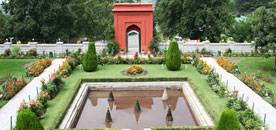
Chashma Shahi :
Chashma Shahi ("Royal Spring") received its name from its water source, a spring located on its uppermost terrace. The garden, one of the smaller Kashmiri gardens around Dal Lake, is found on the southeastern side of the lake. Chashmashahi is the smallest of the three Mughal gardens of Kashmir. Meaning Royal Spring, this garden measures 108 m by 38 m and is above the Nehru Memorial Park. Mughal Emperor Shah Jahan set up the Kashmir Chashma Shahi Mughal Gardens in 1632 AD. 